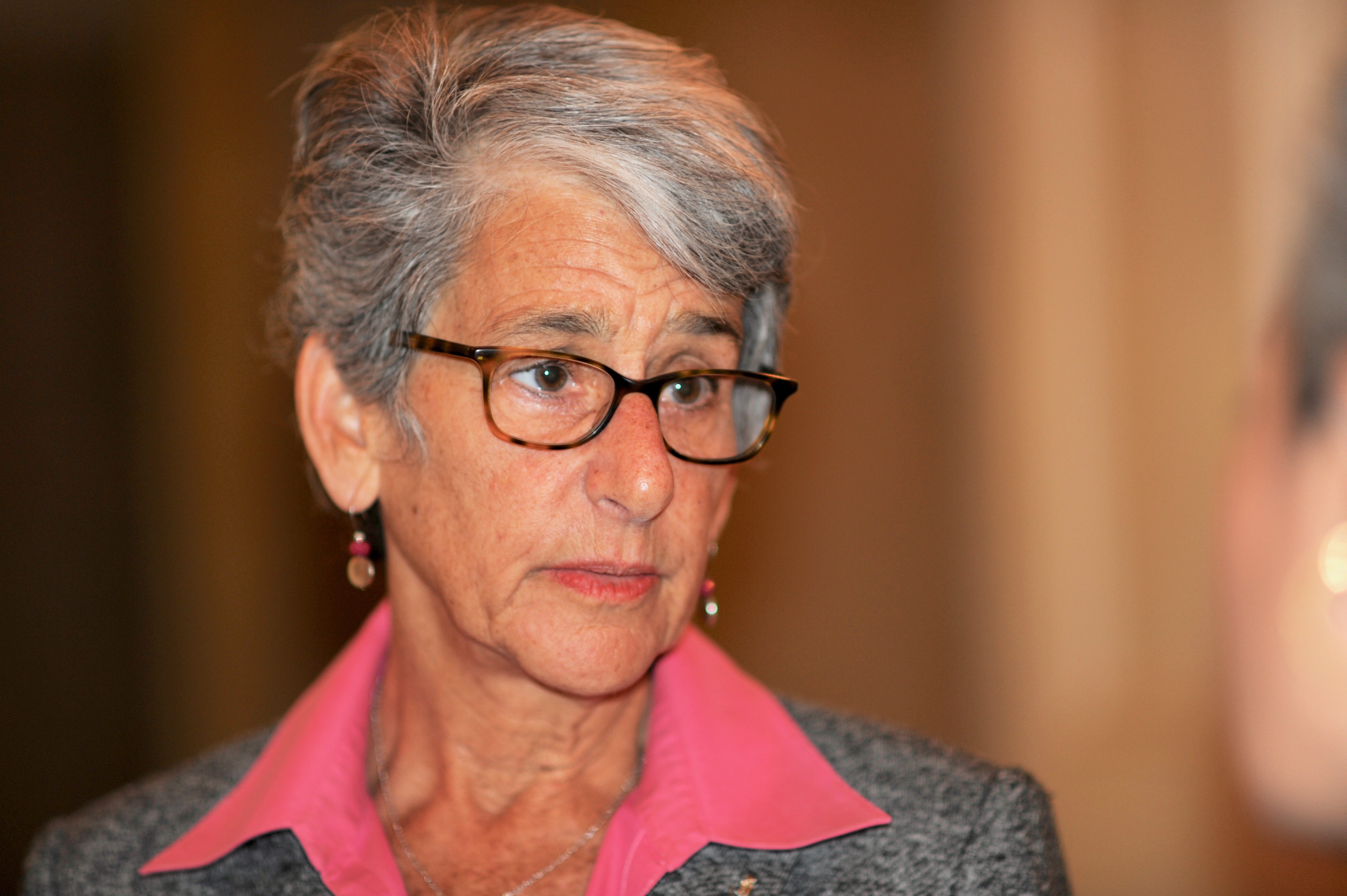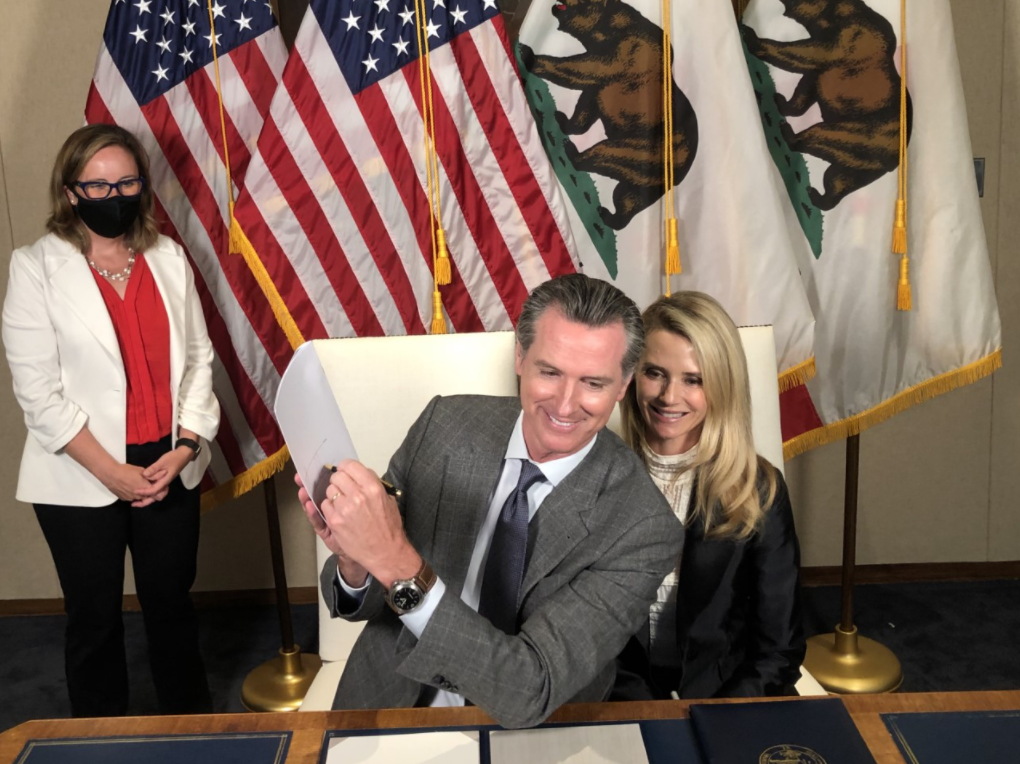
Sen. Hannah-Beth Jackson. (Photo: Kevin Sanders for California Globe)
SB 1383 – Expanding California’s Family Rights Act
Employer must provide employee a guarantee of employment, upon granting the leave request
By Chris Micheli, September 19, 2020 7:51 am
On September 17, Governor Gavin Newsom signed Senate Bill 1383, by Senator Hannah-Beth Jackson (D-Santa Barbara), into law as Chapter 86. The bill to expand protected-family leave, amended Government Code Section 12945.2, added Section 12945.2, and amended Section 12945.6.
Section 1 of the bill amended Government Code Section 12945.2 in order to repeal the code section on January 1, 2021 and replace it with a new version in the same code section. As such, Section 2 of the bill adds a new Section 12945.2 to the Government Code.
Subdivision (a) provides that it is an unlawful employment practice for any employer to refuse to grant a request by any employee with more than 12 months of service with the employer, and who has at least 1,250 hours of service with the employer during the previous 12-month period, to take up to a total of 12 workweeks in any 12-month period for family care and medical leave.
Moreover, family care and medical leave requested is not deemed to have been granted unless the employer provides the employee, upon granting the leave request, a guarantee of employment in the same or a comparable position upon termination of the leave. The Fair Employment and Housing Council is required to adopt a regulation specifying the elements of a reasonable request.
Subdivision (b) defines the following terms: “child,” “domestic partner,” “employer,” “family care and medical leave,” “employment in the same or a comparable position,” “FMLA,” “grandchild,” “grandparent,” “health care provider,” “parent,” “parent-in-law,” “serious health condition,” and “sibling.” The following definitions are of particular importance:
“Employer” means either any person who directly employs five or more persons (had previously been 50 or more persons) to perform services for a wage or salary, or the state and any political or civil subdivision of the state and cities.
“Family care and medical leave” means leave for reason of the birth of a child of the employee; to care for a child, parent, grandparent, grandchild, sibling, spouse, or domestic partner who has a serious health condition; because of an employee’s own serious health condition that makes the employee unable to perform the functions of the employee’s position; because of a qualifying exigency related to the covered active duty or call to covered active duty of an employee’s family member.
“Serious health condition” means an illness, injury, impairment, or physical or mental condition that involves either inpatient care in a hospital or facility, continuing treatment or continuing supervision by a health care provider.
Subdivision (c) prohibits an employer from being required to pay an employee for any leave taken under this law. Subdivision (d) provides that an employee may elect, or an employer may require the employee, to substitute for this leave any of the employee’s accrued vacation leave or other accrued time off during this period or any other paid or unpaid time off negotiated with the employer. However, an employee cannot use sick leave during a period of leave in connection with the birth or care of a child, or to care for a child, parent, grandparent, grandchild, sibling, spouse, or domestic partner with a serious health condition, unless mutually agree.
Subdivision (e) requires that, during leave taken by an employee, the employer must maintain and pay for coverage under a group health plan, but not to exceed 12 workweeks in a 12-month period commencing on the date leave taken under FMLA commences. It must be the same coverage had the employee continue in employment during the leave. The employer can recover the premium paid for this coverage only if the employee fails to return from leave and the employee’s failure to return is for a reason other than a continuing or recurring serious health condition.
In addition, an employee taking this leave is entitled to continue participating in employee health plans, employee benefit plans, including life insurance or disability or accident insurance, pension and retirement plans, and supplemental unemployment benefit plans. An employee can be required to pay premiums at the group rate during the period of leave not covered by any accrued vacation leave or other time off.
Subdivision (f) specifies that, during a family care and medical leave period, the employee retains employee status with the employer and this leave does not constitute a break in service for purposes of longevity, seniority, or any employee benefit plan. Subdivision (g) states that, if the employee’s need for leave is foreseeable, then the employee must provide the employer with reasonable advance notice of the need for the leave.
Subdivision (h) provides that, if the employee’s need for leave is foreseeable due to a planned medical treatment or supervision, the employee must make a reasonable effort to schedule the treatment or supervision to avoid disruption to the operations of the employer, subject to a health care provider’s approval.
Subdivision (i) permits an employer to require an employee’s request for leave to be supported by a certification issued by the health care providers of the individual requiring care. The certification must contain the date the serious health condition commenced, the probably duration of the condition, an estimate of the amount of time that the health care provider believes the employee needs, and a statement that the serious health condition warrants participation of a family member to provide care during a period of the treatment. In addition, the employer may require the employee to obtain recertification if additional leave is required.
Subdivision (j) allows an employer to require that an employee’s request for leave because of the employee’s own serious health condition be supported by a certification issued by the employee’s health care provider. That certification must include the data on which the serious health condition commenced, the probably duration of the condition, and a statement that the employee is unable to perform his or her functions.
In addition, if the employer has reason to doubt the validity of the certification, the employer may require (at the employer’s expense) that the employee obtain the opinion of a second health care provider designated or approved by the employer. Moreover, as a condition of an employee’s return from leave, the employer may have a uniformly applied practice or policy that requires the employee to obtain certification from the employee’s health care provider that the employee is able to resume work.
Subdivision (k) specifies that it is an unlawful employment practice for an employer to refuse to hire, or to discharge, fine, suspend, expel, or discriminate against any individual because of an individual’s exercise of the right to family care and medical leave or an individual’s giving information or testimony as to the individual’s own family care and medical leave, or another person’s care and leave.
Subdivision (l) prevents this section from being construed to require any changes in existing collective bargaining agreements during the life of the contract or until January 1, 1993, whichever occurs first. Subdivision (o) provides that leave may be taken in one or more periods, and that the 12-month period must run concurrently with the 12-month period under the FMLA, and commences on the same date that leave taken under the FMLA commences.
Subdivision (p) specifies that leave taken by an employee must run concurrently with leave taken under FMLA, except for any leave taken under FMLA for disability on account of pregnancy, childbirth, or related medical conditions. In addition, the aggregate amount of leave taken under CFRA or FMLA or both cannot exceed 12 workweeks in a 12-month period.
Subdivision (q) provides that it is an unlawful employment practice for an employer to interfere with, restrain, or deny the exercise of any right under this leave. Subdivision (r) provides special qualification rules for an air carrier employee who works as a flight deck or cabin crew member. Subdivision (s) specifies that this new leave becomes operative on January 1, 2021.
Section 3 of the bill amended Government Code Section 12945.6 to specify it remains in effect until January 1, 2021 and then is repealed. This statute contains the New Parental Leave Act, which allows an employee to take up to 12 weeks of parental leave to bond with a new child within one year of the child’s birth, adoption, or foster care placement. It applies to employers with 20-49 employees. Because these individuals are eligible under the expansion of CFRA contains in Section 2 of the bill, this statute is being repealed. As a result, this separate leave law in only in effect during the 2020 calendar year.
- Third Quiz on Where Areas of Law Are Found in the California Codes - December 30, 2025
- Management of Unclaimed Property - December 30, 2025
- Petitions and Responses in Arbitration - December 29, 2025





How about a business bill of rights? The only rights they have in California is to pay and pay and pay and then either leave or go out of business.